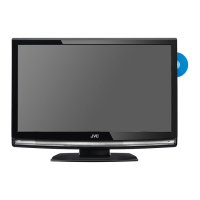
Do you have a question about the JVC LT-32D200 and is the answer not in the manual?
| HD type | Not supported |
|---|---|
| Display diagonal | 32 \ |
| Display brightness | 360 cd/m² |
| Display technology | LCD |
| Native aspect ratio | 16:9 |
| Contrast ratio (typical) | 1200:1 |
| Screen format adjustments | 4:3, 16:9 |
| Power requirements | 120V, 60HZ |
| Operating temperature (T-T) | 5 - 40 °C |
| RMS rated power | 20 W |
| Number of speakers | 2 |
| Equalizer bands quantity | 5 |
| Image formats supported | JPG |
| Optical disc player type | DVD player |
| Digital audio coaxial out | 1 |
| Component video (YPbPr/YCbCr) in | 3 |
| Product color | Black |
| Panel mounting interface | 200 x 100 mm |
| Power consumption (typical) | 160 W |
| Tuner type | Analog & digital |
| Depth (with stand) | 234 mm |
|---|---|
| Width (with stand) | 760 mm |
| Height (with stand) | 563 mm |
| Weight (with stand) | 9800 g |
| Depth (without stand) | 127.5 mm |
| Height (without stand) | 519.3 mm |
| Weight (without stand) | 9300 g |
General safety guidelines and warnings for operating the apparatus safely.
Information regarding FCC compliance and potential radio/TV interference.
Lists all items included with the television, such as remote control and batteries.
Step-by-step guide on how to securely attach the TV stand to the unit.
Details the various features and capabilities available in TV mode.
Details the various features and capabilities available in DVD mode.
Identifies and describes the purpose of each button on the TV's control panel.
Explains the various input and output jacks on the unit for connectivity.
Details the operation of each button on the remote control for TV and DVD modes.
Instructions on how to insert batteries into the remote control.
Guidance on connecting the unit to an antenna or cable television service.
Instructions for connecting external video sources like cable or satellite boxes.
Explains how to connect devices using HDMI and HDMI-DVI interfaces.
Details connecting devices via component video and S-Video inputs.
Instructions for standard RCA video connections.
Guide for connecting external audio devices via digital or analog outputs.
How to connect the TV to a PC and use it as a monitor.
Tips for organizing cables and connecting the power cord safely.
Step-by-step guide to configure language, channels, and location settings.
How to select channels and control the audio volume.
Instructions for setting the automatic turn-off timer for the TV.
How to pause the screen image and cycle through input sources.
Guide to selecting different audio modes for TV and DTV broadcasts.
How to display current channel, audio mode, and program details.
How to adjust the screen's aspect ratio for different video signals.
Overview of the main menu and its accessible settings.
Procedure for automatically scanning and memorizing available TV channels.
How to manage the channel list, including skipping channels.
Adding channels manually that were not found by autoscan.
Verifying the quality of the digital TV signal.
Choosing the language for the TV's on-screen menus and prompts.
Guide to customizing brightness, contrast, color, sharpness, and tint.
Adjusting audio modes, equalizer settings, and sound levels.
Configuring volume consistency and selecting audio output.
Setting up basic closed captioning for TV programs.
Advanced settings for digital closed captioning.
Modifying font, color, and style of closed captions.
Implementing parental controls to restrict program access based on ratings.
Blocking specific channels and content based on MPAA rating systems.
Setting parental controls based on TV broadcast rating categories.
Instructions for creating and managing the child lock password.
Adjusting the PC screen position and display when connected via HDMI.
Configuring the unit to reduce power consumption.
Selecting between 'Retail' and 'Home' modes affecting power usage.
Displaying the version of the unit's current software.
Information on supported and unsupported disc formats.
Details on DVD region locking and color system compatibility.
How to start playback, navigate disc menus, and resume playback.
Controlling playback frame by frame for detailed viewing.
Using playback controls for speed adjustment and image magnification.
Methods for locating specific content segments on a disc.
Navigating playback by time and setting up repeat playback modes.
Advanced playback options for customized track or segment repetition.
Checking current playback status, track times, and repeat settings.
Choosing and displaying subtitles in available languages.
Adjusting camera angles for multi-angle scenes and picture dark areas.
Configuring stereo sound modes and virtual surround sound effects.
Setting specific points on a disc for easy recall during playback.
Selecting preferred languages for subtitles and audio tracks.
Configuring audio output features like down sampling and Dolby Digital.
Setting viewing restrictions based on ratings and managing the PIN code.
Adjusting still picture quality and configuring automatic power-off.
Restoring all settings to their factory defaults.
List of codes for various languages used in subtitle and audio settings.
Answers to common operational issues and user queries.
Solutions for various problems such as no power, no picture, or sound issues.
Definitions of technical terms used throughout the manual.
Guidelines for cleaning the unit and when to seek professional service.
Procedure to test the remote control's infrared signal transmission.
Table mapping cable company channel designations to TV display numbers.
Technical details including power, dimensions, weight, and input/output specifications.
Details of the manufacturer's limited warranty, coverage, and exclusions.
